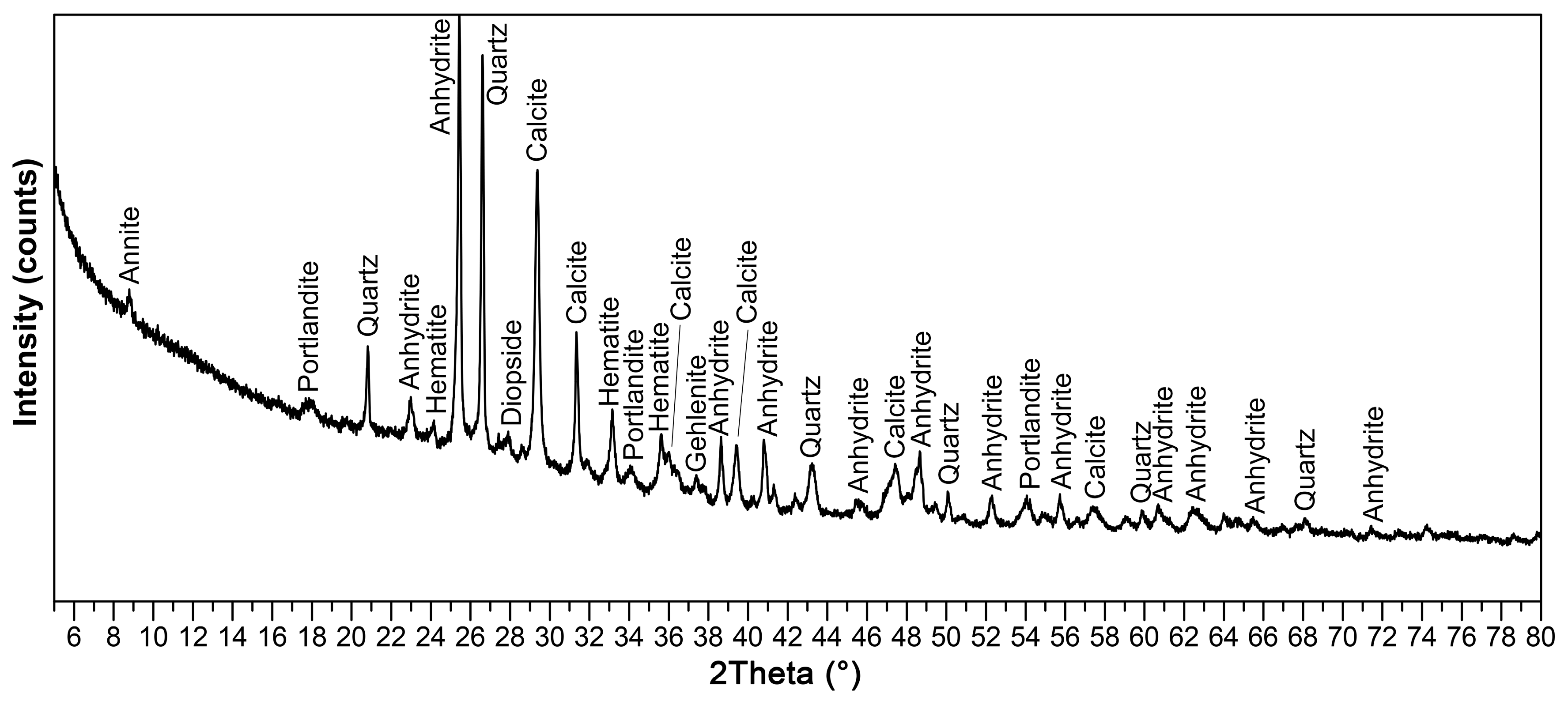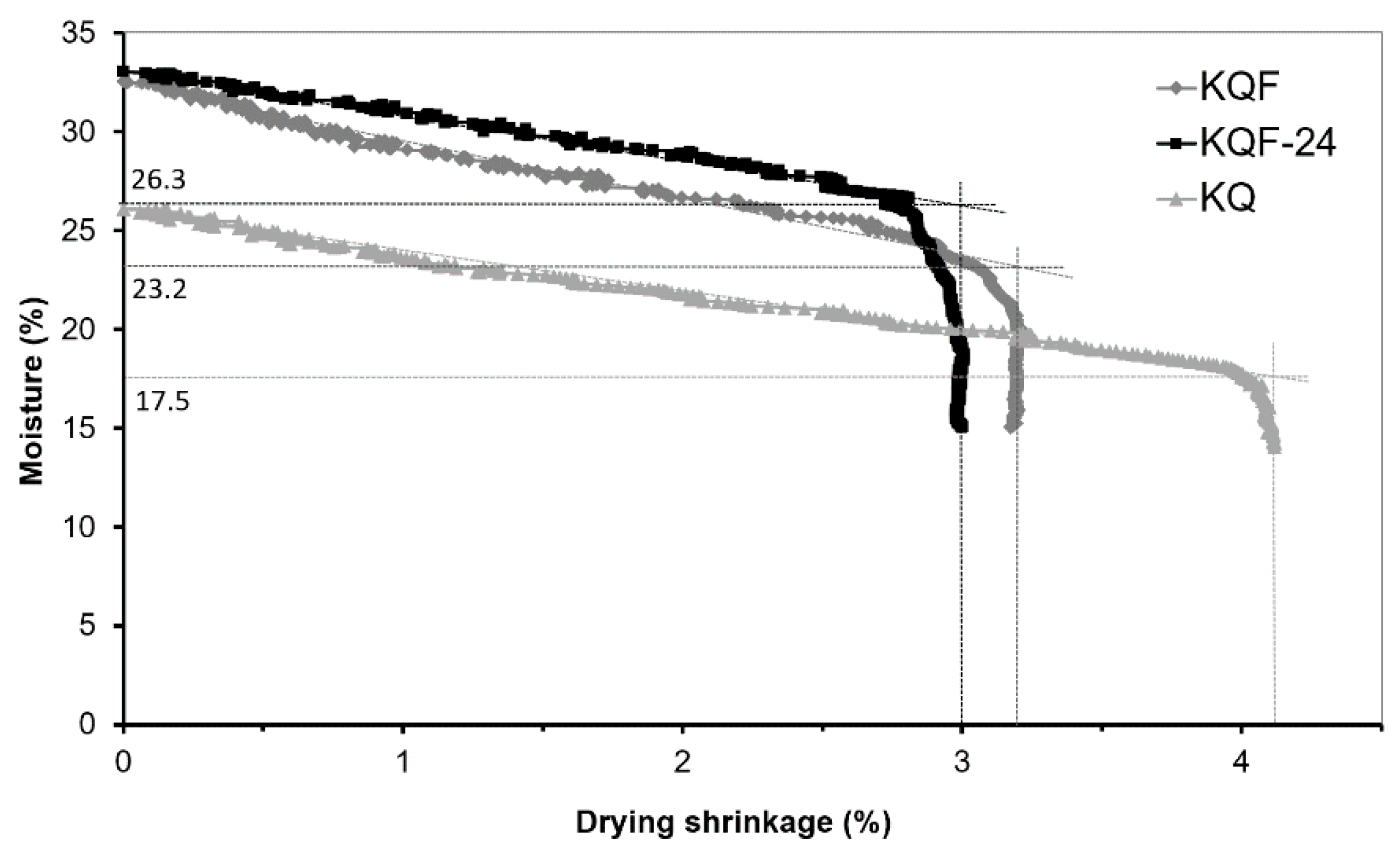The Effect of Class C Fly Ash on the Plasticity and Ageing of Ceramic Mixtures Based on Kaolin
Abstract
:1. Introduction
2. Materials and Methods
2.1. Raw Materials and Test Samples
2.2. Methodology
- 1.
- The dough of the raw material mixtures KQ, KQF and KQFF (Table 4) was made by adding an appropriate amount of initial (mixing) water (Wi) determined by the Pfefferkorn test. The test samples were then formed into a rectangular bar of 100 × 50 × 20 mm3 by hand with the help of a metal form. Some of them were wrapped with a plastic film and kept at room temperature for 24 h ageing (samples KQ-24, KQF-24, KQFF-24) to describe the Bigot curve of the aged body with higher Hf (Figures 4, 5 and 6). The dough’s ageing refers to the process of the dough maturing with mixing water (to achieve Hf = 30 mm) in a plastic cover without the possibility of drying;
- 2.
- The test samples were put on a balance (reproducibility 0.01 g) with two cylindrical supports. The changes in the length (100 mm) were continually observed using a contactless Micro-Epsilon OptoNCDT 1420 laser triangulation sensor (Bechyne, Czech Republic) (reproducibility 0.5 µm). The specimen was kept in a room protected from airflow for 24 h;
- 3.
- The specimen was dried at 110 °C until the weight became constant, and the length of the dried specimen was measured to calculate the drying shrinkage (DS). The graph of the relationship between shrinkage and water content was plotted (Bigot curve). The Drying Sensitivity Index—Bigot DSI-B was calculated using the following equation:where:DSI-B = [(Wi − Wc)·DS]/100Wi is the initial water content of the dough during test samples’ preparation (%);Wc is the critical water content of test samples subtracted from the Bigot curve (Figure 3) (%);DS is drying shrinkage after drying at 110 °C (%).
3. Results and Discussion
4. Conclusions
Author Contributions
Funding
Data Availability Statement
Conflicts of Interest
References
- Mollamahmutoglu, M.; Yilmaz, Y.; Güngör, G.A. Effect of a Class C Fly Ash on the Geotechnical Properties of an Expansive Soil. Int. J. Eng. Res. Dev. 2009, 1, 1–6. [Google Scholar]
- Hayder, H.A. Effect of Fly Ash on Geotechnical Properties of Expansive soil. J. Eng. Dev. 2012, 16, 306–316. [Google Scholar]
- Yin, C.; Zhang, W.; Jiang, X.; Huang, Z. Effects of Initial Water Content on Microstructure and Mechanical Properties of Lean Clay Soil Stabilized by Compound Calcium-Based Stabilizer. Materials 2018, 11, 1933. [Google Scholar] [CrossRef] [PubMed] [Green Version]
- Mir, B.A. Some studies on the effect of fly ash and lime on physical and mechanical properties of expansive clay. Int. J. Civ. Eng. 2015, 13, 1–12. [Google Scholar]
- Cheshomi, A.; Eshaghi, A.; Hassanpour, J. Effect of lime and fly ash on swelling percentage and Atterberg limits of sulfate-bearing clay. Appl. Clay Sci. 2017, 135, 190–198. [Google Scholar] [CrossRef]
- Jafera, H.; Atherton, W.; Sadique, M.; Ruddock, F.; Loffill, E. Stabilisation of soft soil using binary blending of high calcium fly ash and palm oil fuel ash. Appl. Clay Sci. 2018, 152, 323–332. [Google Scholar] [CrossRef]
- Gaidzinski, R.; Duailibi, J.; Tavares, L.M. Influence of aging on the technological properties of clays in the ceramic industry. Appl. Clay Sci. 2011, 54, 47–52. [Google Scholar] [CrossRef]
- Shahriar, A.R.; Jadid, R. An experimental investigation on the effect of thixotropic aging on primary and secondary compression of reconstituted dredged clays. Appl. Clay Sci. 2018, 162, 524–533. [Google Scholar] [CrossRef]
- Andreola, F.; Castellini, E.; Ferreira, J.M.F.; Olhero, S.; Romagnoli, M. Effect of sodium hexametaphosphate and ageing on the rheological behaviour of kaolin dispersions. Appl. Clay Sci. 2006, 31, 56–64. [Google Scholar] [CrossRef]
- Queralt, I.; Querol, X.; López-Soler, A.; Plana, F. Use of coal fly ash for ceramics: A case study for a large Spanish power station. Fuel 1997, 76, 787–791. [Google Scholar] [CrossRef]
- Little, M.R.; Adell, V.; Boccaccini, A.R.; Cheeseman, C.R. Production of novel ceramic materials from coal fly ash and metal finishing wastes. Resour. Conserv. Recycl. 2008, 52, 1329–1335. [Google Scholar] [CrossRef]
- Abbas, S.; Saleem, M.A.; Kazmi, S.M.S.; Munir, M.J. Production of sustainable clay bricks using waste fly ash: Mechanical and durability properties. J. Build. Eng. 2017, 14, 7–14. [Google Scholar] [CrossRef]
- Sokolar, R.; Nguyen, M. Influence of Class C Fly Ash on the Properties of Plastic Clay and Fired Brick Body. Mater. Tehnol. 2020, 54, 107–111. [Google Scholar] [CrossRef]
- Biffi, G. Book for the Production of Ceramic Tiles, 1st ed.; Gruppo Editionale: Faenza, Italy, 2003. [Google Scholar]
- Zimmer, A.; Bergmann, C.P. Fly ash of mineral coal as ceramic tiles raw material. Waste Manag. 2007, 27, 59–68. [Google Scholar] [CrossRef] [PubMed]
- Hemra, K.; Yamaguchi, S.; Kobayashi, T.; Aungkavattana, P.; Jiemsirilers, S. Compressive Strength and Setting Time Modification of Class C Fly Ash-Based Geopolymer Partially Replaced with Kaolin and Metakaolin. Key Eng. Mat. 2018, 766, 157–163. [Google Scholar] [CrossRef]
- Nivedya, K. Study on the Effect of pH on the Atterberg Limits of Kaolinitic and Montmorillonitic Clay. Geotech. Characterisation Geoenvironmental Engl. 2018, 1, 251–256. [Google Scholar]
- Modesto, C.O.; Bernardin, A.M. Determination of clay plasticity: Indentation method versus Pfefferkorn method. Appl. Clay Sci. 2008, 40, 15–19. [Google Scholar] [CrossRef]
- Pfefferkorn, K. Ein Beitrag zur Bestimmung der Plastizität in Tonen und Kaolinen. Sprechsaal 1924, 57, 297–299. [Google Scholar]
- Grim, R.E. Clay Mineralogy, 2nd ed.; Mc-Graw Hill: New York, NY, USA, 1968; p. 596. [Google Scholar]
- Ryan, W.; Radford, C. Whitewares Production, Testing and Quality Control, 1st ed.; Pergamon Press: New York, NY, USA, 1987; p. 333. [Google Scholar]
- Händle, F. Rheology and Extrudability of Ceramic Compounds. In Extrusion in Ceramics, 1st ed.; Derby., B., Ed.; Springer: New York, NY, USA, 2007; pp. 175–188. [Google Scholar]
- Bigot, A. Retrait au Sechage des Kaolins et Argiles. Rep. Acad. Sci. 1921, 755–758. [Google Scholar]
- Aungatichart, P.; Wada, S. Correlation between Bigot and Ratzenberger drying sensitivity indices of red clay from Ratchaburi province (Thailand). Appl. Clay Sci. 2009, 42, 182–185. [Google Scholar] [CrossRef]
- Ho, L.S.; Nakarai, K.; Eguchi, K.; Ogawa, Y. Difference in Strength Development between Cement-treated Sand and Mortar with Various Cement Types and Curing Temperatures. Materials 2020, 13, 4999. [Google Scholar] [CrossRef] [PubMed]
- Liu, W.; Hou, H.; Zhang, C. Feasibility study on solidification of municipal solid waste incinerator fly ash with circulating fluidized bed combustion coal fly ash. WM&R 2009, 27, 258–266. [Google Scholar]








| Material | SiO2 | Al2O3 | Fe2O3 | MnO | TiO2 | CaO | MgO | K2O | Na2O | SO3 | LOI |
|---|---|---|---|---|---|---|---|---|---|---|---|
| Kaolin 1) | 46.80 | 36.60 | 0.90 | 0.00 | 1.70 | 0.70 | 0.50 | 1.20 | 0.00 | 13.2 | |
| Quartz sand 1) | 99.60 | 0.20 | 0.05 | 0.00 | 0.00 | 0.10 | 0.10 | 0.00 | 0.20 | ||
| CCFA 2) | 35.00 | 23.30 | 5.50 | 0.10 | 5.40 | 21.50 | 1.60 | 0.50 | 0.10 | 2.50 | 4.50 |
| Granulometry Parameters | Kaolin | Quartz Sand | Fly Ash |
|---|---|---|---|
| R63 (wt. %) | 0.0 | 14.5 | 25.2 |
| R43 (wt. %) | 0.0 | 19.2 | 36.2 |
| Specific surface area (m2·kg−1) | 1750 | 317 | 284 |
| Sample | Kaolin (wt. %) | Quartz Sand (wt. %) | Fly Ash (wt. %) |
|---|---|---|---|
| KQ | 50 | 50 | 0 |
| KQF | 50 | 40 | 10 |
| KQFF | 50 | 30 | 20 |
| Sample | Wi 1 (wt. %) | Bulk Density of Green Body (wt. %) | Bulk Density of Green Body Aged for 24 h (wt. %) |
|---|---|---|---|
| KQ(-24) | 25.8 | 1730 | 1730 |
| KQF(-24) | 32.0 | 1565 | 1530 |
| KQFF(-24) | 34.1 | 1470 | 1390 |
| Mixture | KQ | KQ-24 | KQF | KQF-24 | KQFF | KQFF-24 |
|---|---|---|---|---|---|---|
| DSI-B (-) | 0.34 | 0.34 | 0.28 | 0.17 | 0.14 | 0.08 |
| MOR (MPa) | 0.72 | 0.75 | 0.66 | 0.58 | 1.48 | 1.02 |
Publisher’s Note: MDPI stays neutral with regard to jurisdictional claims in published maps and institutional affiliations. |
© 2021 by the authors. Licensee MDPI, Basel, Switzerland. This article is an open access article distributed under the terms and conditions of the Creative Commons Attribution (CC BY) license (https://creativecommons.org/licenses/by/4.0/).
Share and Cite
Sokolar, R.; Nguyen, M. The Effect of Class C Fly Ash on the Plasticity and Ageing of Ceramic Mixtures Based on Kaolin. Materials 2021, 14, 2761. https://doi.org/10.3390/ma14112761
Sokolar R, Nguyen M. The Effect of Class C Fly Ash on the Plasticity and Ageing of Ceramic Mixtures Based on Kaolin. Materials. 2021; 14(11):2761. https://doi.org/10.3390/ma14112761
Chicago/Turabian StyleSokolar, Radomir, and Martin Nguyen. 2021. "The Effect of Class C Fly Ash on the Plasticity and Ageing of Ceramic Mixtures Based on Kaolin" Materials 14, no. 11: 2761. https://doi.org/10.3390/ma14112761






